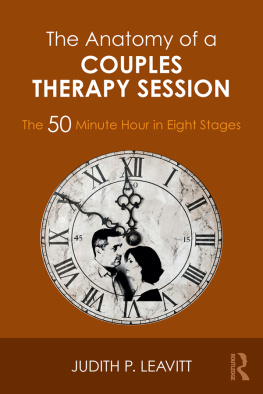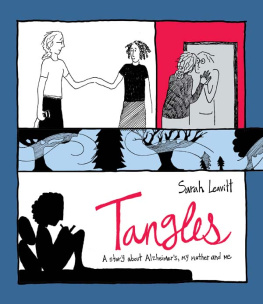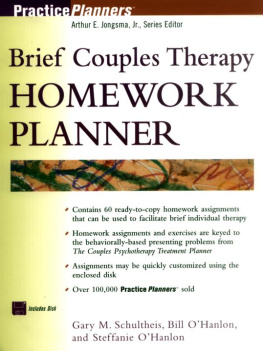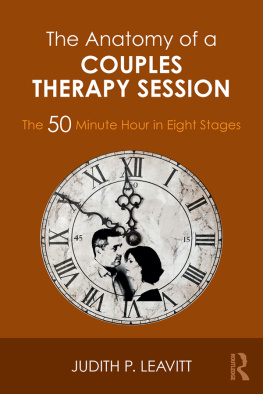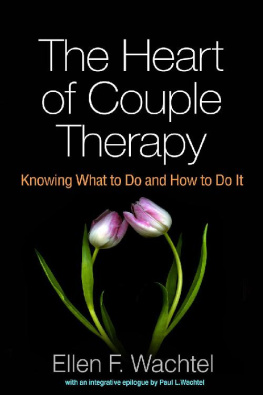Leavitt - The anatomy of a couples therapy session the 50 minute hour in eight stages
Here you can read online Leavitt - The anatomy of a couples therapy session the 50 minute hour in eight stages full text of the book (entire story) in english for free. Download pdf and epub, get meaning, cover and reviews about this ebook. City: New York;NY, year: 2018, publisher: Taylor & Francis Ltd;Routledge, genre: Home and family. Description of the work, (preface) as well as reviews are available. Best literature library LitArk.com created for fans of good reading and offers a wide selection of genres:
Romance novel
Science fiction
Adventure
Detective
Science
History
Home and family
Prose
Art
Politics
Computer
Non-fiction
Religion
Business
Children
Humor
Choose a favorite category and find really read worthwhile books. Enjoy immersion in the world of imagination, feel the emotions of the characters or learn something new for yourself, make an fascinating discovery.
- Book:The anatomy of a couples therapy session the 50 minute hour in eight stages
- Author:
- Publisher:Taylor & Francis Ltd;Routledge
- Genre:
- Year:2018
- City:New York;NY
- Rating:3 / 5
- Favourites:Add to favourites
- Your mark:
- 60
- 1
- 2
- 3
- 4
- 5
The anatomy of a couples therapy session the 50 minute hour in eight stages: summary, description and annotation
We offer to read an annotation, description, summary or preface (depends on what the author of the book "The anatomy of a couples therapy session the 50 minute hour in eight stages" wrote himself). If you haven't found the necessary information about the book — write in the comments, we will try to find it.
Leavitt: author's other books
Who wrote The anatomy of a couples therapy session the 50 minute hour in eight stages? Find out the surname, the name of the author of the book and a list of all author's works by series.
The anatomy of a couples therapy session the 50 minute hour in eight stages — read online for free the complete book (whole text) full work
Below is the text of the book, divided by pages. System saving the place of the last page read, allows you to conveniently read the book "The anatomy of a couples therapy session the 50 minute hour in eight stages" online for free, without having to search again every time where you left off. Put a bookmark, and you can go to the page where you finished reading at any time.
Font size:
Interval:
Bookmark:

How does a couples therapist actually run a 50 minute session? What needs to happen? What must happen? Managing this time and knowing how to guide a couple through what can be a rocky roller coaster ride is a critical skill. This volume breaks down the entire 50 minutes of a couples therapy session from beginning to end. It divides the 50 minutes into eight time period stages that may overlap. The distinctive characteristics and challenges of each time period are examined. Numerous case examples are given throughout the book. The couples therapist is addressed directly with many suggestions given for handling the situations that can arise in each period. In addition, the couples therapists own experiences during the session are explored.
Judith P. Leavitt, EdD, is a senior clinician, licensed psychologist, and Diplomate Certified Sex Therapist with over 35 years of clinical experience. She has a private practice in Wayland, Massachusetts, where she works with individuals, couples, and families. At the William James College, a graduate college in psychology in Newton, Massachusetts, she is an adjunct faculty, teaching couples therapy and human sexuality.
Judith P. Leavitt, Ed.D.

First published 2018
by Routledge
711 Third Avenue, New York, NY 10017
and by Routledge
2 Park Square, Milton Park, Abingdon, Oxon, OX14 4RN
Routledge is an imprint of the Taylor & Francis Group, an informa business
2018 Taylor & Francis
The right of Judith P. Leavitt, to be identified as author of this work has been asserted by her in accordance with sections 77 and 78 of the Copyright, Designs and Patents Act 1988.
All rights reserved. No part of this book may be reprinted or reproduced or utilized in any form or by any electronic, mechanical, or other means, now known or hereafter invented, including photocopying and recording, or in any information storage or retrieval system, without permission in writing from the publishers.
Trademark notice: Product or corporate names may be trademarks or registered trademarks, and are used only for identification and explanation without intent to infringe.
Library of Congress Cataloging-in-Publication Data
A catalog record for this book has been requested
ISBN: 978-1-138-06833-9 (hbk)
ISBN: 978-1-138-06834-6 (pbk)
ISBN: 978-1-315-15804-4 (ebk)
Typeset in Caslon Pro
by Keystroke, Neville Lodge, Tettenhall, Wolverhampton
Dedication
To my high school teacher Janet Jacobs who was the first person to give me confidence in my ability to write.
A deep thanks to Dean Abby and Alan Dodge Beck of William James College, both of whom gave me the opportunity to develop my ideas about working with couples through teaching couples therapy.
Special thanks to my editor George Zimmar for believing in this book.
I also want to acknowledge the great support of my partner, George Hecker, through my writing process. He helped me with his input, support, patience, and insights.
And a profound thanks to all the couples with whom I have worked over the years. You have been and continue to be my teachers.
As I sit there waiting for Lena and Derek to come in, I wonder what is in store for me. Will they be yelling at each other? Will they be in a deep freeze? Will the room start to feel like the air has been sucked out of it? Will one of their children have acted up? Will one of their parents have become sick? And what of Dereks job issues that permeate the relationship? Will we be able to continue with last weeks session? Will we build on skills that they are developing? Will we delve into one of the deeper issues in their relationship? I may have a plan for how the session is going to go. Yet anyone who has done couples therapy knows how quickly a plan may be scuttled. Anyone who has done couples therapy knows how even in the middle of the session everything can turn upside down. Doing couples therapy can be similar to a jazz improvisation. It is at once creative, exciting, unknown. It is building on themes, familiar tunes, and well-trained structures. At the same time, at any given moment a session can fall apart and not work. One must be flexible, quick, focused, and on top of ones game.
Much has been written about how to do couples therapy. There are many schools of thought and approaches, such as structural/strategic family therapy, narrative therapy, behavioral therapy, etc. In my graduate couples therapy class I teach many of these approaches. I am able to find many references for students to gain understanding of the issues and complexities of this work. The one thing I cannot find are specific references about the anatomy of a couples therapy session. How does one run an actual session? There are books on how to do an assessment, how to give feedback, how to work on communication, how to handle specific issues. Many couples therapy approaches present steps and exercises to be used in the course of couples therapy. However, there is not material available focused on the specific 50 minutes of an actual session. In case studies, authors sometimes describe a particular session and may give actual dialogue from that specific session. These sessions most often show only a part of a sessionusually the most significant part. They illustrate the application of a specific theoretical approach and/or technique. But rarely do they describe the whole session from beginning to end, thus showing the different phases of the session and the important transitions from one phase to the next. Yet, there is a great deal of rich material to be explored about what takes place during the confines of a specific whole session. Running a couples therapy session can feel like a marvelous dance, a dreadful encounter, an opportunity for total failure. It can feel like jumping off a cliff and flying or crashing.
Writing this book was a joy. Often as I was working on a section, I would look over the couples sessions I had had that week. Material would pour out as I thought about what had happened. This was particularly true when I was working on certain sections, such as the different types of sessions described in , Full Steam Ahead. Suddenly I would realize that a session I had run that week was a whole different type of session than those that I had described to date. It was exciting as it seemed like the material was limitless. I could then hardly wait for new sessions to occur so I could see if these sessions gave me yet more new material. There are undoubtedly types of sessions that will occur to you as readers as you go through this book. I invite you to add to the lists of ideas here.
My writing experience reinforced how creative couples therapy can be. Writing this book was a lot like doing a couples session: exciting, fun, playful, serious, challenging, and demanding, i.e. an experience with a full range of feelings.
Doing couples therapy demands that we as therapists be in the moment. There is a great deal that is happening right there in the room. A skilled couples therapist needs to absorb all that is happening, mix it in with his or her skills, handle often intense emotions, and find a helpful direction. This work can be among the most electrifying and challenging types of therapy a therapist can do. At the heart of the work is the session that is happening right now.
Font size:
Interval:
Bookmark:
Similar books «The anatomy of a couples therapy session the 50 minute hour in eight stages»
Look at similar books to The anatomy of a couples therapy session the 50 minute hour in eight stages. We have selected literature similar in name and meaning in the hope of providing readers with more options to find new, interesting, not yet read works.
Discussion, reviews of the book The anatomy of a couples therapy session the 50 minute hour in eight stages and just readers' own opinions. Leave your comments, write what you think about the work, its meaning or the main characters. Specify what exactly you liked and what you didn't like, and why you think so.

